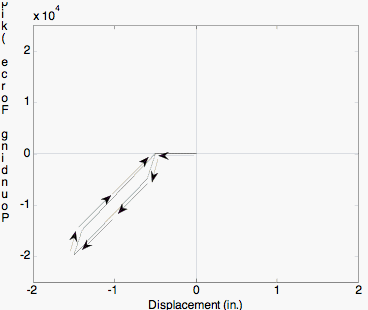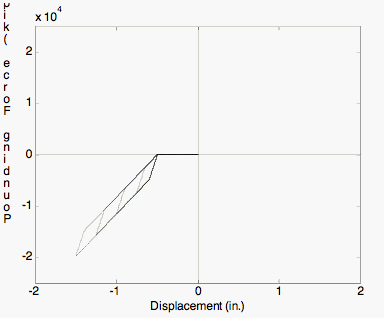Impact Material: Difference between revisions
No edit summary |
No edit summary |
||
| Line 19: | Line 19: | ||
|'''$gap '''|| initial gap* | |'''$gap '''|| initial gap* | ||
|} | |} | ||
NOTES: | NOTES: | ||
This material is implemented as a compression-only gap material. Delta_y and gap should be input as negative values. | This material is implemented as a compression-only gap material. Delta_y and gap should be input as negative values. | ||
DESCRIPTION: | DESCRIPTION: | ||
| Line 42: | Line 36: | ||
The yield displacement is: | The yield displacement is: | ||
<math> | <math>d=ad/math> | ||
where a is typically taken as 0.1. The initial stiffness, K1, and secondary stiffness, K2, are then selected such that the Impact model dissipates an amount of energy during a pounding event that is consistent with the associated energy dissipated in the Hertz model. | where a is typically taken as 0.1. The initial stiffness, K1, and secondary stiffness, K2, are then selected such that the Impact model dissipates an amount of energy during a pounding event that is consistent with the associated energy dissipated in the Hertz model. | ||
| Line 49: | Line 43: | ||
<math>Insert formula here</math> | <math>Insert formula here</math> | ||
Response of Impact Material during a pounding event. | |||
[[Image:ImpactA.gif]] | |||
Response of Impact Material for displacement cycles of increasing amplitude. | |||
[[Image:ImpactB.gif]] | |||
EXAMPLE: | EXAMPLE: | ||
Revision as of 22:12, 20 November 2009
This command is used to construct an impact material object
| uniaxialMaterial ImpactMaterial $matTag $K1 $K2 $Delta_y $gap
|
| $matTag | integer tag identifying material |
| $K1 | initial stiffness |
| $K2 | secondary stiffness |
| $Delta_y | yield displacement |
| $gap | initial gap* |
NOTES:
This material is implemented as a compression-only gap material. Delta_y and gap should be input as negative values.
DESCRIPTION:
This material is based on an approximation to the Hertz contact model proposed by Muthukumar (See REFERENCES below). The energy dissipated during impact is:
<math>Insert formula here</math>
where kh is the impact stiffness parameter, with a typical value of EA/L or 25,000 k-in.-3/2; n is typically taken as 3/2 for the exponent associated with the Hertz power rule; e is the coefficient of restitution, with typical values from 0.6-0.8; and δm is the maximum penetration during the pounding event. The effective stiffness, Keff, is: <math>Insert formula here</math>
The yield displacement is:
<math>d=ad/math>
where a is typically taken as 0.1. The initial stiffness, K1, and secondary stiffness, K2, are then selected such that the Impact model dissipates an amount of energy during a pounding event that is consistent with the associated energy dissipated in the Hertz model.
<math>Insert formula here</math>
<math>Insert formula here</math>
Response of Impact Material during a pounding event.
Response of Impact Material for displacement cycles of increasing amplitude.
EXAMPLE:
REFERENCES:
Muthukumar, S., and DesRoches, R. (2006). “A Hertz Contact Model with Non-linear Damping for Pounding Simulation.” Earthquake Engineering and Structural Dynamics, 35, 811-828.
Muthukumar, S. (2003). “A Contact Element Approach with Hysteresis Damping for the Analysis and Design of Pounding in Bridges.” PhD Thesis, Georgia Institute of Technology. http://smartech.gatech.edu/
Nielson, B. (2005). “Analytical Fragility Curves for Highway Bridges in Moderate Seismic Zones.” PhD Thesis, Georgia Institute of Technology. http://smartech.gatech.edu/
Code Developed by: Mathew Dryden, UC Berkeley

